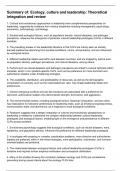Summary of: Ecology, culture and leadership: Theoretical
integration and review
1. Cultural and evolutionary approaches to leadership have complementary perspectives on
leadership, supported by evidence from various disciplines including management, psychology,
economics, anthropology, and biology.
2. Societal and ecological factors, such as population density, natural disasters, and pathogen
prevalence, influence the emergence of particular cultural leadership prototypes (CLPs) in different
societies.
3. The prevailing answer in the leadership literature is that CLPs are mainly seen as socially
learned preferences stemming from societal conditions, norms, and practices, and are influenced
by ecological factors.
4. Different leadership ideals exist within and between countries, and are shaped by factors such
as population density, pathogen prevalence, and natural disasters, among others.
5. Factors such as natural disasters and pathogen prevalence are linked to cultural tightness within
societies, which in turn predicts specific CLPs, such as the preference for more dominant and
authoritarian leaders under threatening ecologies.
6. The availability, distribution, and predictability of resources, as well as the demographic
composition of a society, such as the male-biased sex ratio, may shape leadership ideals and
preferences.
7. Intense intergroup conflicts and war-like situations are associated with a preference for
dominant, authoritarian leaders who demonstrate strength, dominance, and aggression.
8. The environmental context, including ecological factors, historical immigration, and sex ratios,
has implications for followers' preferences for leadership traits, such as emotional expressiveness,
communication style, and dominance, as a response to local ecological conditions.
9. Research suggests that a deeper integration of cultural and evolutionary perspectives on
leadership is needed to understand the complex relationship between cultural leadership
prototypes and ecological factors, shedding light on the emergence and persistence of different
CLPs across societies.
1. Evolutionary psychology suggests that ecological conditions, such as natural disasters, wars,
epidemics, and population density, influence the preference for different leadership prototypes.
2. In ecologies with pressing or complex coordination problems, more directive and authoritarian
leaders are preferred, while in low-threat ecologies, more participative, charismatic, and humane-
oriented leaders are preferred.
3. The relationship between ecological factors and cultural leadership prototypes (CLPs) is
tentative and requires further empirical verification and conceptual clarification.
4. Many of the studies showing the correlation between ecology and CLPs are correlational,
preventing strong causal claims about the ecology-CLPs links.




